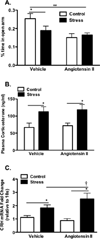T lymphocytes and vascular inflammation contribute to stress-dependent hypertension
- PMID: 22361077
- PMCID: PMC3354001
- DOI: 10.1016/j.biopsych.2012.01.017
T lymphocytes and vascular inflammation contribute to stress-dependent hypertension
Abstract
Background: Psychological stress is a significant risk factor for hypertension and also directly affects the immune system. We have previously reported that T lymphocytes are essential for development of hypertension and that the central nervous system contributes to peripheral T-lymphocyte activation and vascular inflammation in this disease; however, the role of T-cell activation in stress-related hypertension remains unclear.
Methods: Wild-type and T-cell-deficient (RAG-1(-/-)) mice were subjected to daily episodes of stress and blood pressure was measured. Circulating T-cell activation markers and vascular infiltration of immune cells were analyzed, as were stress hormone levels and gene expression changes in the brain. The effects angiotensin II infusion in the presence of chronic stress was also studied.
Results: Repeated daily stress contributed to acute elevations in blood pressure that were associated with increased activation of circulating T cells and increased vascular infiltration of T cells. Repeated stress increased blood pressure in wild-type but not RAG-1(-/-) mice. Adoptive transfer of T cells to RAG-1(-/-) mice restored blood pressure elevation in response to stress. Stress-related hypertension and vascular infiltration of T cells was markedly enhanced by angiotensin II. Moreover, angiotensin II-infused mice exposed to chronic stress exhibited greater blood pressure reactivity to an episode of acute stress.
Conclusions: These data demonstrate that stress-dependent hypertension triggers an inflammatory response that raises blood pressure at baseline and augments the hypertension caused by angiotensin II. These data provide insight as to how psychological stress contributes to hypertension.
Copyright © 2012 Society of Biological Psychiatry. Published by Elsevier Inc. All rights reserved.
Conflict of interest statement
Figures






References
-
- Gasperin D, Netuveli G, Dias-da-Costa JS, Pattussi MP. Effect of psychological stress on blood pressure increase: A meta-analysis of cohort studies. Cad Saude Publica. 2009;25:715–726. - PubMed
-
- Esler M, Eikelis N, Schlaich M, Lambert G, Alvarenga M, Dawood T, et al. Chronic mental stress is a cause of essential hypertension: Presence of biological markers of stress. Clin Exp Pharmacol Physiol. 2008;35:498–502. - PubMed
-
- Matthews KA, Katholi CR, McCreath H, Whooley MA, Williams DR, Zhu S, et al. Blood pressure reactivity to psychological stress predicts hypertension in the cardia study. Circulation. 2004;110:74–78. - PubMed
-
- Strogatz DS, Croft JB, James SA, Keenan NL, Browning SR, Garrett JM, et al. Social support, stress, and blood pressure in black adults. Epidemiology. 1997;8:482–487. - PubMed
Publication types
MeSH terms
Substances
Grants and funding
LinkOut - more resources
Full Text Sources
Medical

